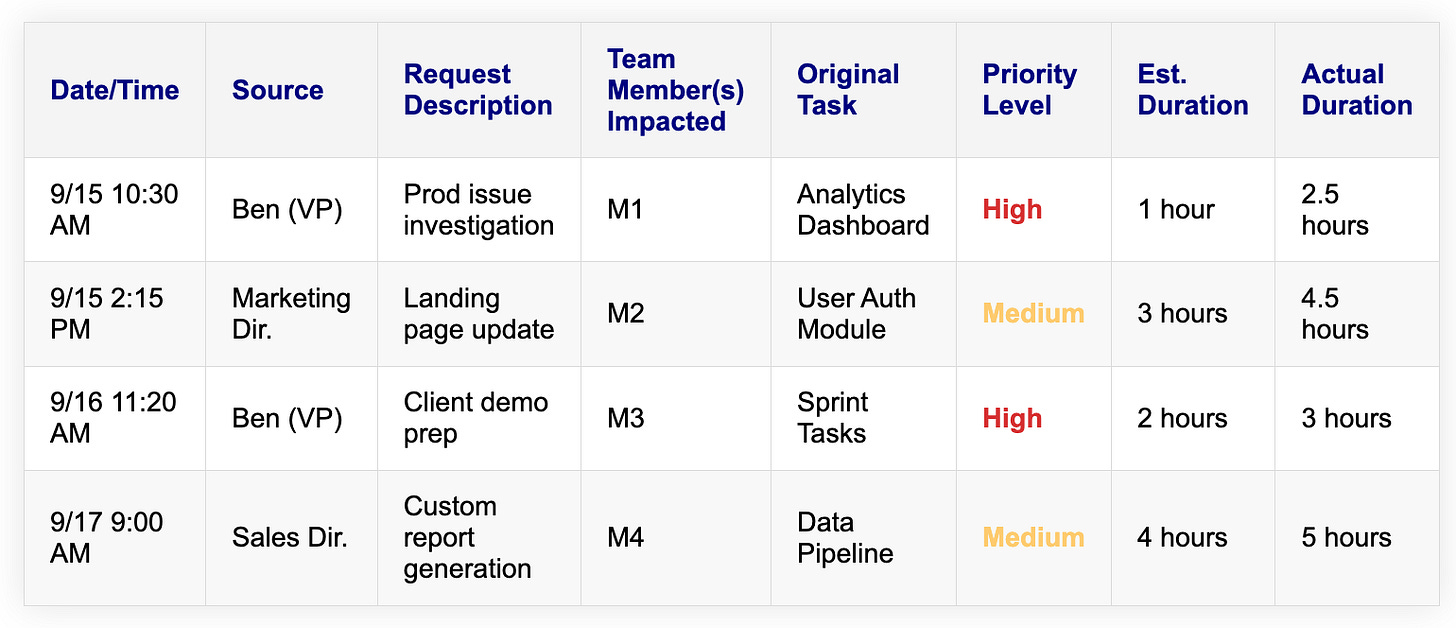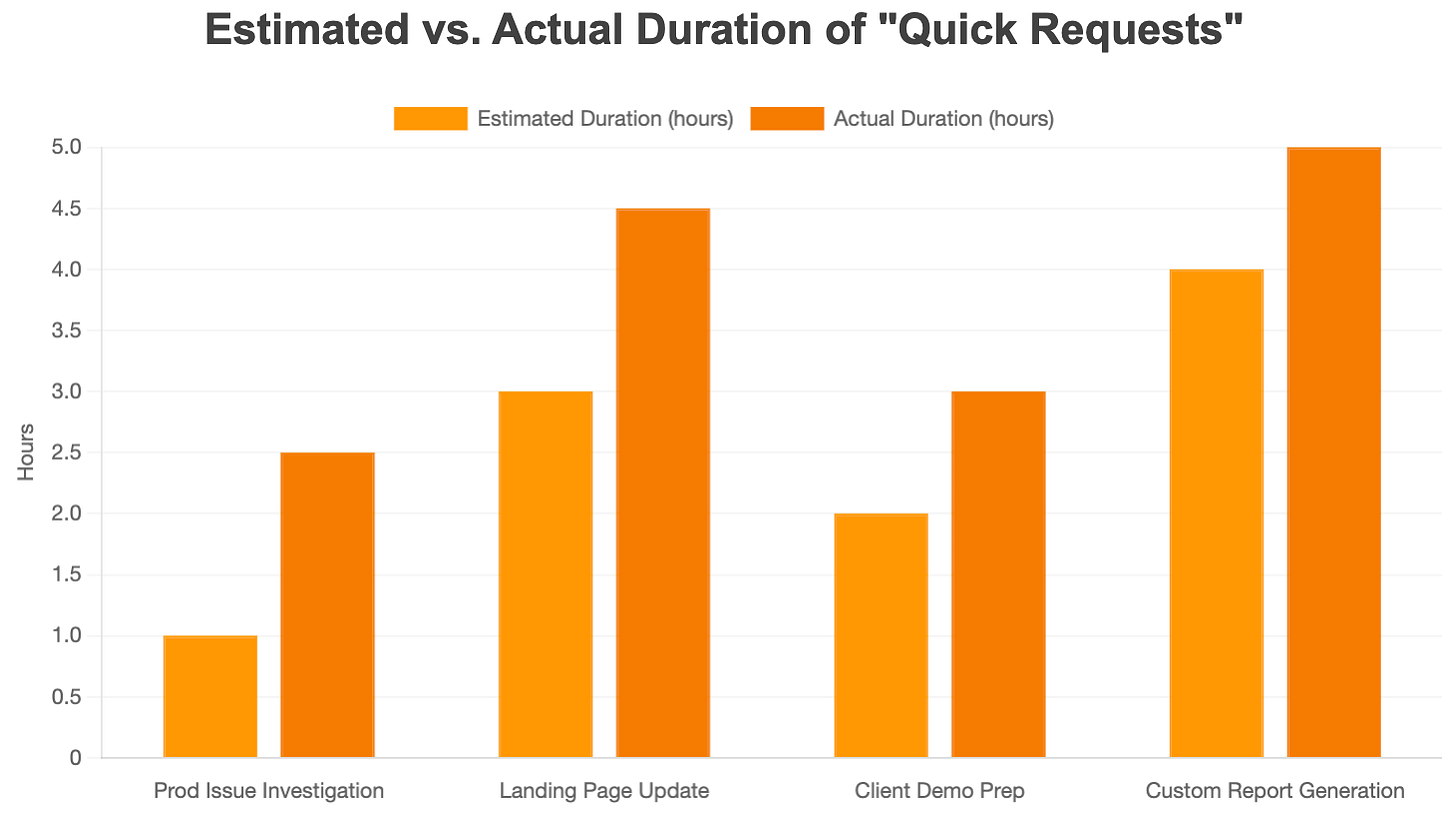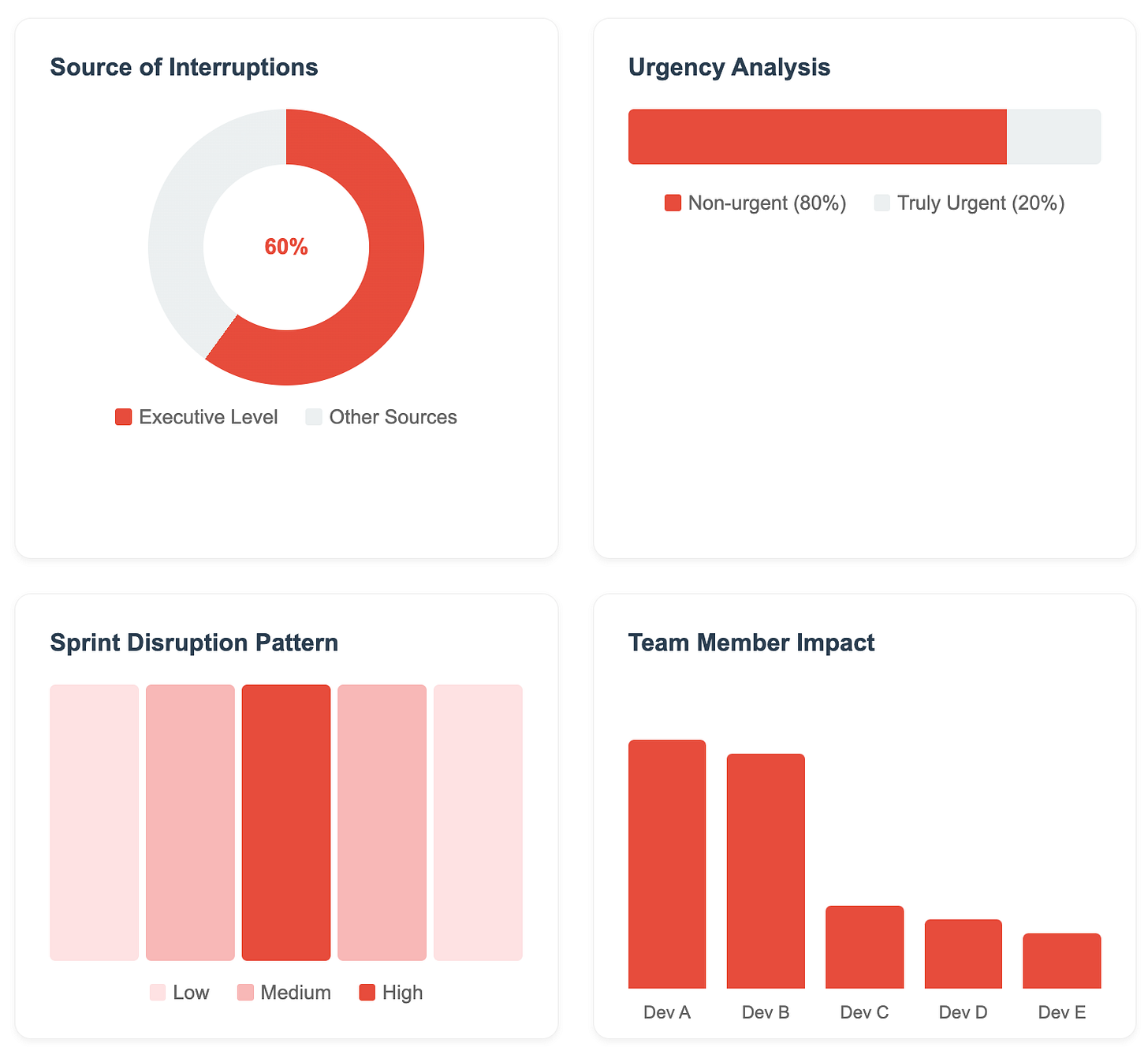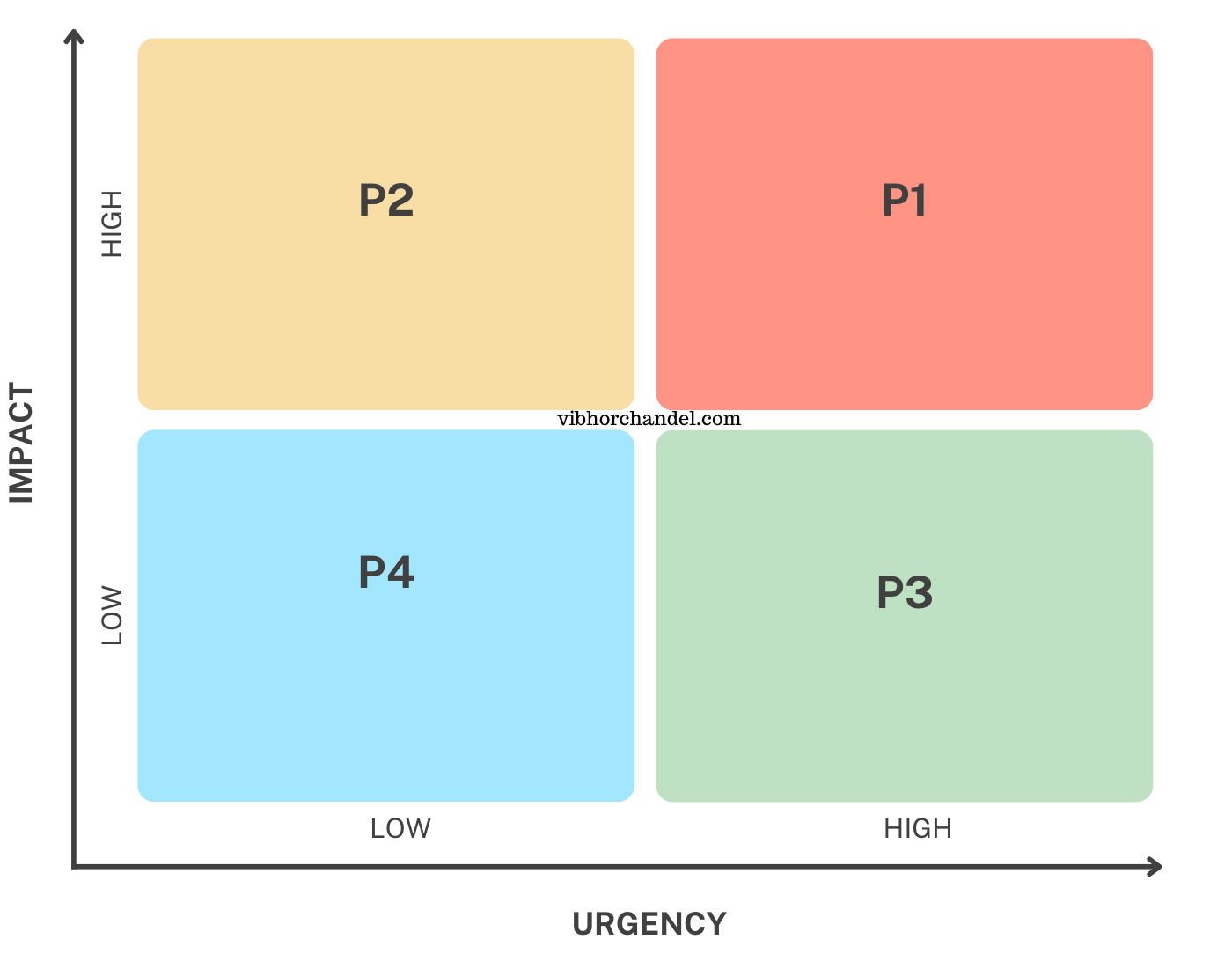When Management Interferes
How I Learned the Right Way of Protecting the Team from Constant Scope Changes and Mid-Sprint Interruptions?
Welcome to the 🔥 free edition 🔥 of Winning Strategy: a newsletter focused on enhancing product, process, team, and career performance. This newsletter shares insights gained from real-world experiences that I gathered working at Twitter, Amazon, and now as an Executive Product Coach at one of North America's largest banks. If you’d like to become a paid member, see the benefits here, and feel free to use this expense template to ask your manager.
"Stop everything! We need this done by tomorrow!"
The words teams around the world dread echoed in my team space. It was 2:30 PM on a Wednesday, right in the middle of our sprint, when a senior VP announced another "urgent priority" for my team.
Scrum Masters know this scene all too well.
The product backlog is organized, the team's commitments are clear, and their velocity is steady. Morale is high — until chaos walks in wearing a business suit.
But what if I told you there's a way to handle this without burning out your team or burning bridges with management?
This post details a real-world “incident” from my time at Twitter, where my colleague, Aman, faced this exact challenge and turned it into an opportunity for organizational transformation.
You’ll learn how to:
shield the team from mid-sprint interruptions
streamline the process to minimize disruptions
help shift the organizational mindset toward understanding Agile roles and processes
Let’s get started.
Background
The year was 2009.
Agile frameworks were gaining traction, but many organizations were still figuring out how to implement them effectively.
Aman, a Project Manager at Twitter, was reviewing her team's latest sprint metrics with growing concern. While her official title was Project Manager, she effectively took on the responsibilities of a Scrum Master, guiding her team through the complexities of Agile. It's important to note that formal Scrum Master roles were not yet common in many companies, including Twitter, at that time.
It was nearing the end of September, and the numbers that Aman was looking at painted a troubling picture of her team.
Pre-Interruption Period:
- Velocity: 45 story points
- Sprint Goal Achievement: 95%
- Team Satisfaction: 8.5/10
- Technical Debt: 15% of backlog
During Interruption Period:
- Velocity: 27 story points
- Sprint Goal Achievement: 35%
- Team Satisfaction: 5.2/10
- Technical Debt: 35% of backlogOver the past three months, the team’s performance had declined significantly.
The team she led was responsible for Twitter’s core analytics engine, a critical platform component. They had been one of the first teams in the company to adopt Scrum, and under Aman’s guidance, they had quickly become one of the most efficient and reliable teams.
Predictable delivery, high-quality features, and consistent progress had earned them a “super team” reputation.
The team consisted of 8 highly skilled members:
- 5 senior developers
- 2 QA engineers
- 1 Product Manager (who served as the unofficial Product Owner)"The irony was that our success became our biggest challenge." - Aman
Their reputation for consistent delivery had made them the preferred team for urgent requests. Senior management, particularly the VP — let's call him Ben —appeared to support Agile practices publicly, but he frequently bypassed the Product Owner to assign tasks directly to team members.
"In the fast-moving social media world, we can't afford to wait for the next sprint," was Ben’s standard justification.
Other stakeholders began following suit, leading to a series of mid-sprint interruptions that impacted the team's performance:
- sprint predictability dropped from 90% to 35%
- team velocity decreased from 45 to 27 story points
- unplanned work consumed 40% of the team's sprint capacity
- 3 major production issues occurred in the past month due to rushed testingThe team’s sprints were now firefighting sessions.
Developers were frustrated, QA engineers were overwhelmed, and the Product Manager struggled to maintain any semblance of a prioritized backlog.
Aman knew that this situation couldn’t continue. If the team didn’t regain control, burnout would kill the team.
As she prepared her notes, she knew she needed a solid strategy to address these challenges. The situation required process improvements and a fundamental shift in how management interacted with the Agile team concept.
The question was: How?
How could she protect her team while maintaining positive relationships with senior stakeholders who held traditional views about project management?
Aman needed a plan.
Sprint Interruption Tracker Tool
As a valued paid member of Winning Strategy, you can download the beta release of the Sprint Interruption Tracker tool by clicking on the link below.
I created this tool to help track and visually represent Sprint interruptions, and I am now excited to share it with the Winning Strategy community.
Initial Assessment and Data Collection
"We needed hard data, not just feelings. Without concrete numbers, any conversation with stakeholders would've been just another opinion."
Her first step was creating a systematic way to track and quantify the impact of interruptions. Using an Excel sheet with six tabs, she documented every instance where stakeholders bypassed the established process.
Tab 1: Interruption Log
The first tab captured detailed information about each unplanned request that disrupted the team's sprint work:
The data was revealing. In just two weeks:
- 12 unplanned requests disrupted the sprint
- Senior stakeholders were the source of 50% of interruptions
- Actual task duration consistently exceeded estimates by 35-50%
- Team members were pulled away from critical sprint commitmentsMost notably, the data showed that what stakeholders considered "quick requests" routinely took 2-3 times longer than estimated, creating a cascade effect on sprint deliverables.
To prove this, she quantified “Context Switching” in the next tab.
Tab 2: Time Impact Analysis
Aman recognized that measuring just the interruption time wouldn't tell the whole story. Each “task-switch” carried hidden costs that needed to be quantified.
She worked with the team to track three key metrics beyond the actual interruption time:
- Context Switch Time: The setup time needed to shift to the new task
- Resume Time: Time required to get back into the original task
- Sprint Points Affected: Impact on planned deliverablesThe data revealed a concerning pattern.
Example:
The 2.5-hour interruption to the Analytics Dashboard resulted in a total of 4.25 hours of impact when factoring in context switching and resume time.
“What surprised us most was the ripple effect. A two-hour interruption didn't just cost two hours. The mental reset time, the impact on code quality, the delayed reviews - it all added up.”
Tab 3: Quality Incidents
Another area of concern was the impact on quality. Aman reviewed the team's recent bug reports and testing logs to identify incidents that could be traced back to rushed or incomplete testing. Things like:
-rushed code reviews leading to technical debt
-skipped test cases to meet urgent deadlines
-integration issues from parallel work streams
-production bugs requiring immediate fixesTab 4: Delayed Feature Releases
To further illustrate the cost of these interruptions, Aman identified their ripple effects on the team’s planned deliverables.
Over the two-week period, three key feature releases were delayed because team members were pulled away to address unplanned work.
The total financial impact across these delays amounted to $35,000 per day in lost revenue opportunity.
Tab 5: Process Metrics
To quantify the full scope of interruption impacts, Aman gathered key Scrum metrics that track team health and performance. These metrics were particularly important because they:
provided objective evidence of productivity changes
highlighted systemic issues beyond individual incidents
demonstrated the broader organizational cost of interruptions
established a baseline for measuring future improvements
The before-and-after comparison revealed concerning trends across all major performance indicators:
Tab 6: Financial Impact
Finally, Aman estimated the financial impact of these disruptions. Aman worked with Finance to determine:
-average hourly cost per team member
-cost of delayed feature releases
-customer impact of quality incidents
-additional overtime costsUsing a simple calculation based on hourly rates and lost productivity, she arrived at an estimated cost of $45,000 over the two-week period (excluding Additional Impact).
This figure was powerful.
It translated the abstract concept of "lost efficiency" into something tangible that senior management could understand.
End of assessment
By the end of the two-week assessment, Aman had a solid picture of the problem. The data painted a compelling story of how unplanned interruptions were eroding her team’s efficiency.
Armed with this information, Aman was ready to move to the next step: Present her findings to Ben (the VP) and propose an actionable solution.
Presenting the Data
"I needed to translate technical metrics into business impact. Executives don't always connect with Agile terminology, but they respond to financial implications and market signals."
1. Financial Impact (Tab 6)
Aman used the Pyramid Principle and began her presentation by leading with what she knew would resonate most: the financial cost of interruptions.
She broke the $45,000 cost into five categories:
- Direct Costs ($3,750): Development hours lost to unplanned work.
- Hidden Costs ($5,550): Time lost due to context-switching.
- Quality Costs ($1,950): Emergency fixes caused by rushed work.
- Overtime Costs ($3,375): Burnout indicators from overworked team members.
- Opportunity Costs ($30,375): Delayed features that competitors had already released."The opportunity costs caught Ben's attention. Especially when I showed how our Facebook released similar features during our delays, effectively capturing market share we could have had."
2. Quality Impact (Tab 3)
Next, Aman connected interruptions to quality issues, framing them as direct business risks:
- Each production bug affected an average of 10,000 users
- Service downtime impacted premium customers
- Technical debt accumulated, threatening future delivery speed“When I explained how these bugs and downtime were eroding customer trust, I could see the concern on their faces,”
3. Team Capacity Analysis (Tabs 1 & 2)
To illustrate the human toll of interruptions, Aman shared a detailed analysis of the “interruption cascade”:
- A 2.5-hour interruption actually consumed 4.25 hours when including context-switching, highlighting the hidden costs of task switching.
- Team members were working at 120% capacity (Tab 5), pushing them to their limits.
- Overtime was becoming normalized, increasing the risk of burnout and decreased productivity.
- Key features were consistently delayed by 2-3 sprints, impacting the team's ability to meet deadlines.“I explained that this wasn’t sustainable. Burnout was no longer a possibility — it was becoming a reality.”
4. Sprint Metrics (Tab 5)
To connect the team’s struggles to broader business objectives, Aman translated Scrum metrics into language stakeholders could understand:
- A 40% velocity drop meant a 40% slower time-to-market.
- A 61% drop in sprint predictability made it harder to deliver on commitments to customers.
- A 500% increase in quality incidents was driving up customer dissatisfaction.“When I framed these metrics as delays in delivering value to customers, the room went quiet.”
5. Overall Interruption Analysis (Tab 1)
Finally, Aman presented an analysis of the root cause of interruptions:
- 60% of interruptions came from executive-level stakeholders.
- 80% of 'urgent' requests could have waited until the next sprint.
- Most interruptions happened mid-sprint, creating maximum disruption.
- The same team members were repeatedly interrupted, leading to knowledge silos and overburdened individuals."The breakthrough came when I showed Ben how many 'urgent' requests weren’t truly urgent. Of the 12 unplanned requests we tracked, only two required immediate attention. The rest could have been prioritized in our normal sprint planning."
Ben was convinced.
But!
“What’s the solution?” he asked.
Presenting the data didn’t eliminate interruptions; it simply made people aware of a “problem” that needed attention.
Important Lesson: Never go to an Executive with a Problem. Go to them with a Problem + Potential Solution.
Fortunately, Aman came prepared.
The Solution
Aman's proposed solution was a structured intervention designed to address the root causes of the team's challenges. It focused on three key areas:
Immediate Relief: Stabilizing the team and reducing disruptions
Long-Term Process Improvements: Establishing sustainable workflows to manage emergent work
Cultural Transformation: Aligning senior stakeholders with Agile ways of working
Her plan was designed to protect the team’s Agile practices, restore productivity, and rebuild trust between the team and senior leadership.
The plan was implemented in three distinct phases:
Phase 1: Emergency Response
The immediate priority was to stop the constant mid-sprint interruptions and provide the team with the space they needed to focus on their sprint commitments.
Key actions included:
Temporary Moratorium: A temporary stop was imposed on all mid-sprint interruptions except for critical P1 issues (e.g. system downtime, major security breaches, or critical data loss). This provided the team with much-needed breathing room
Immediate Buffer: A 15% sprint capacity buffer was introduced to handle urgent but non-critical items without derailing planned work. This buffer also provided a small window to address technical debt and make small improvements
Sprint Capacity Allocation: - 70% Planned work - 15% Emergency buffer - 15% Technical debt/improvementsProduct Owner Empowerment: Senior leaders were requested to route all urgent issues through the Product Owner
“By implementing these measures, the team immediately experienced relief. They could focus on delivering their planned work without constant interruptions.”
Phase 2: Process Implementation
With immediate relief in place, the focus shifted on establishing sustainable processes for handling emergent work.
Key initiatives included:
1. Priority Assessment Matrix: A new framework was introduced to help stakeholders categorize their requests:
P1 (Critical): Revenue impact > $1M, system downtime, major security breaches, or critical data loss
P2 (High): Major client impact, regulatory compliance issues, or significant business opportunities
P3 (Moderate): Business opportunities that can wait for the next sprint without a major impact
P4 (Low): Standard feature requests, minor bugs, or non-urgent improvements
“This matrix gave stakeholders a clear, objective way to evaluate the urgency of their requests. It also reduced unnecessary disruptions.”
2. Change Control Board (CCB): A formal approval process was introduced for mid-sprint changes. The CCB consisted of:
The Product Owner, who assessed the business impact and alignment with strategic goals
A Technical Lead who evaluated the technical feasibility and potential risks of the proposed change
A Business Stakeholder Representative who advocated for the urgency and business value of the request
A neutral facilitator who ensured the process was followed and that decisions were made fairly
Process:
All urgent requests were submitted to the CCB for review
Only P1 and P2 requests (based on predefined criteria) were approved for mid-sprint action
Lower-priority items (P3 and P4) were added to the backlog for future sprint planning, ensuring they were not forgotten but also did not disrupt ongoing work
Phase 3: Cultural Transformation
Aman used this opportunity to plug in monthly "Agile Leadership Workshops" for executives, focusing on:
- The hidden costs of context switching
- The value of sprint predictability, and
- The ROI of proper Agile implementation“To which most executives agreed.”
Also,
Aman shared monthly updates with executives, showing measurable improvements in team metrics.
“It worked!”
Resistance and Adaptation
It wasn’t as easy as it looked, though.
“The changes weren't implemented without challenges. One month into the new process, Ben attempted to bypass the CCB for a "critical" client request.”
Ben wasn’t the only one resistant to change. Other stakeholders struggled to adjust to the new system.
“Many stakeholders were frustrated at first. They were used to pushing their requests straight to the team and getting immediate attention. For some, waiting for the next sprint felt like losing control.”
To build trust with her team, Aman made it a point to shield the team from unnecessary escalations during the first few weeks. She worked closely with the Product Owner to enforce the new setup as much as possible.
The matrix wasn’t about denying requests.
It was about prioritizing them in a way that maximized value for the business. Over time, as stakeholders began to see the results, their frustration turned into cautious support.
“Slowly and steadily, it kicked in. They started to use CCB for most interruptions. It took its sweet time but when that happened we were all happy.”
One breakthrough moment came during a quarterly review when Aman presented the team's improved metrics.
“When Ben saw those numbers, he acknowledged how the new process had not only improved delivery but also improved team’s productivity.”
Resistance is inevitable when introducing change, especially when it challenges established habits and power dynamics.
Aman’s success lies in her ability to remain flexible, or, in other words, in Agility.
“Change doesn’t happen overnight. But when you stay committed to the principles behind the change—and show people the results—it’s amazing how quickly resistance can turn into support.” - Aman S.
Download — Sprint Interruption Tracker (beta)
A tool to help you do your Initial Analysis by tracking interruptions and visualizing them graphically. It is a beta release.
If you are a paid member of Winning Strategy, you can download the beta release of the Sprint Interruption Tracker tool for free by clicking on the link below.
Connect With Vibhor
Winning Strategy is your source for insights gained from real-world experiences that I gathered working at Twitter, Amazon, and now as an Executive Product Coach at one of North America's largest banks.
















